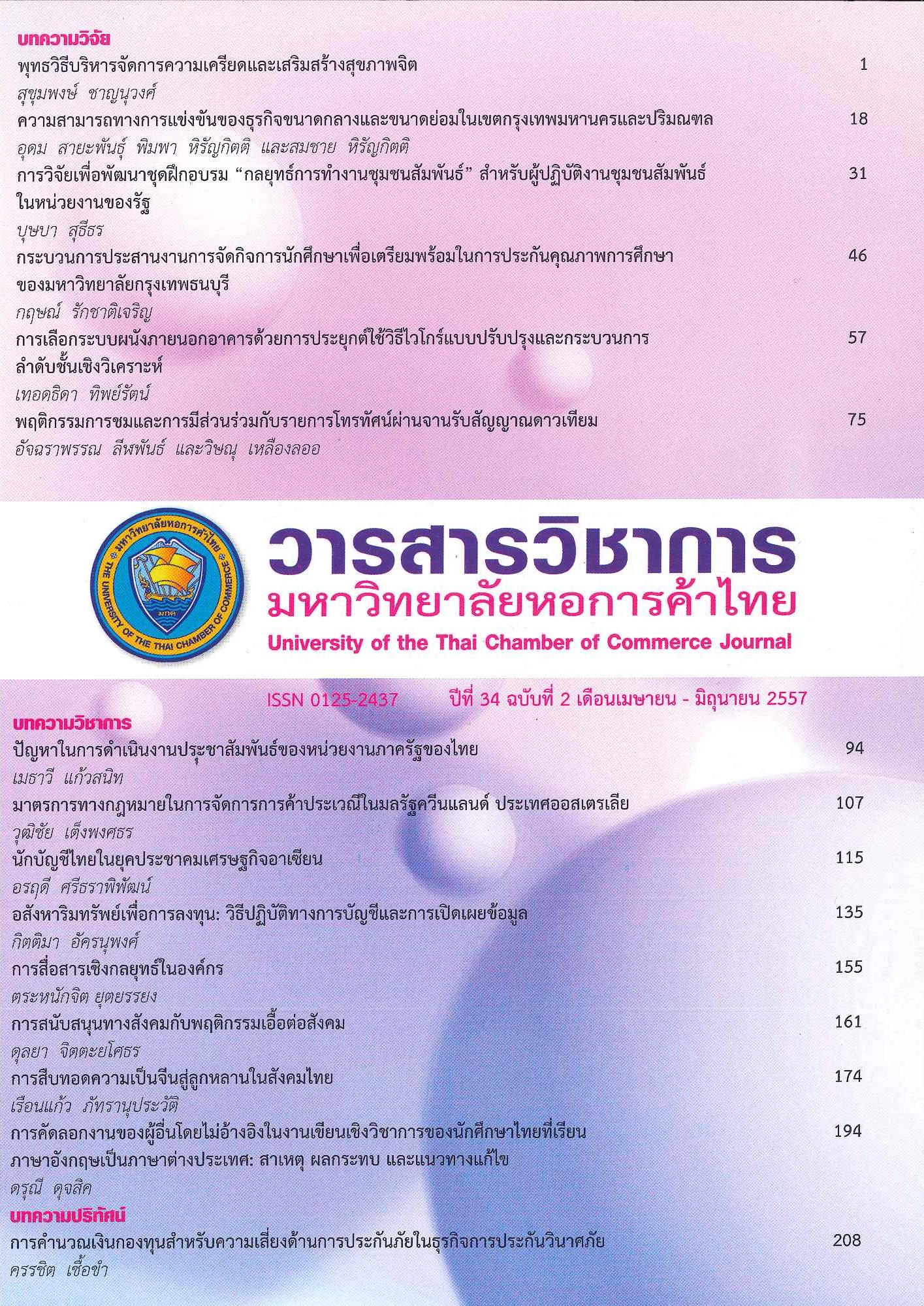Strategic Communication in an Organization
Main Article Content
Abstract
This article aims to explore the significances and roles of strategic communication as tools for building an organization’s reputation. Strategic communication means planned communications with specific targets and objectives. The function of strategic communication is to build an organization’s reputation, image and public trust.
Article Details
How to Cite
Yutyunyong, T. (2014). Strategic Communication in an Organization. University of the Thai Chamber of Commerce Journal Humanities and Social Sciences, 34(2), 155–160. retrieved from https://so06.tci-thaijo.org/index.php/utccjournalhs/article/view/189085
Section
Academic Article

This work is licensed under a Creative Commons Attribution-NonCommercial-NoDerivatives 4.0 International License.
ลิขสิทธิ์ของบทความ
ผลงานที่ได้รับการตีพิมพ์ถือเป็นลิขสิทธิ์ของมหาวิทยาลัยหอการค้าไทย ห้ามมิให้นำเนื้อหา ทัศนะ หรือข้อคิดเห็นใด ๆ ของผลงานไปทำซ้ำ ดัดแปลง หรือเผยแพร่ ไม่ว่าทั้งหมดหรือบางส่วนโดยไม่ได้รับอนุญาตเป็นลายลักษณ์อักษรจากมหาวิทยาลัยหอการค้าไทยก่อน
References
Argenti, P.A., Howell, R.A., and Beck, K.A. 2005. "The Strategic Communication Imperative." MIT Sloan Management Review 46, 3: 83-89.
Balmer, John M.T., and Greyser, Stephen A. 2003. Revealing the Corporation: Perspectives on Identity, Image, Reputation, Corporate Branding, and Corporate-Level Marketing: An Anthology. London: Routledge.
Benjarongkit, Yubol. 2011. Planning and Evaluation for Strategic Communication. Bangkok: Chulalongkorn University. (in Thai).
ยุบล เบ็ญจรงค์กิจ. 2554. การวางแผนและการประเมินผลการสื่อสารเชิงกลยุทธ์. กรุงเทพมหานคร: จุฬาลงกรณ์มหาวิทยาลัย.
Buss, A.H. 1980. Self-Consciousness and Social Anxiety. San Francisco: Freeman.
Cornelissen, Joep. 2008. Corporate Communications: Theory and Practice. London: Sage.
Level, D.A. and Galle, W.P. 1980. Business Communication: Theory and Practice. Dallas, TX: Business Publications.
O'Hair, D., Fried, G.W., and Dixon, L.D. 2005. Strategic Communication in Business and the Professions. Boston, MA: Houghton Mifflin.
Santiwong, Thongchai, and Santiwong, Chaiyot. 1994. Organization Behavior. Bangkok: Thai Wattana Panich. (in Thai).
ธงชัย สันติวงษ์ และชัยยศ สันติวงษ์. 2537. พฤติกรรมบุคคลในองค์การ. กรุงเทพมหานคร: ไทยวัฒนาพานิช.
Balmer, John M.T., and Greyser, Stephen A. 2003. Revealing the Corporation: Perspectives on Identity, Image, Reputation, Corporate Branding, and Corporate-Level Marketing: An Anthology. London: Routledge.
Benjarongkit, Yubol. 2011. Planning and Evaluation for Strategic Communication. Bangkok: Chulalongkorn University. (in Thai).
ยุบล เบ็ญจรงค์กิจ. 2554. การวางแผนและการประเมินผลการสื่อสารเชิงกลยุทธ์. กรุงเทพมหานคร: จุฬาลงกรณ์มหาวิทยาลัย.
Buss, A.H. 1980. Self-Consciousness and Social Anxiety. San Francisco: Freeman.
Cornelissen, Joep. 2008. Corporate Communications: Theory and Practice. London: Sage.
Level, D.A. and Galle, W.P. 1980. Business Communication: Theory and Practice. Dallas, TX: Business Publications.
O'Hair, D., Fried, G.W., and Dixon, L.D. 2005. Strategic Communication in Business and the Professions. Boston, MA: Houghton Mifflin.
Santiwong, Thongchai, and Santiwong, Chaiyot. 1994. Organization Behavior. Bangkok: Thai Wattana Panich. (in Thai).
ธงชัย สันติวงษ์ และชัยยศ สันติวงษ์. 2537. พฤติกรรมบุคคลในองค์การ. กรุงเทพมหานคร: ไทยวัฒนาพานิช.


